List of X-planes

The X-planes are a series of experimental United States aircraft and rockets, used to test and evaluate new technologies and aerodynamic concepts. They have an X designator, which indicates the research mission within the US system of aircraft designations.
Most of the X-planes have been operated by the National Advisory Committee for Aeronautics (NACA) or, later, the National Aeronautics and Space Administration (NASA), often in conjunction with the United States Air Force. The majority of X-plane testing has occurred at Edwards Air Force Base.[1]
Some of the X-planes have been well publicized, while others, such as the X-16, have been developed in secrecy.[2] The first, the Bell X-1, became well known in 1947 after it became the first aircraft to break the sound barrier in level flight.[3] Later X-planes supported important research in a multitude of aerodynamic and technical fields, but only the North American X-15 rocket plane of the early 1960s achieved comparable fame to that of the X-1. X-planes 8, 9, 11, 12, and 17 were actually missiles[4]:14,15,17,18,24 used to test new types of engines, and some other vehicles were un-manned (some were remotely flown, some were partially or fully autonomous).
Most X-planes are not expected to go into full-scale production; one exception was the Lockheed Martin X-35, which competed against the Boeing X-32 during the Joint Strike Fighter Program, and has entered production as the F-35.[5]
Not all US experimental aircraft have been designated as X-planes; some received US Navy designations before 1962,[6] while others have been known only by manufacturers' designations,[N 1] non-'X'-series designations,[N 2] or classified codenames.[N 3]
List
| Type | Manufacturer | Agency | Image | Date | Role | Notes |
|---|---|---|---|---|---|---|
| X-1A | Bell | USAF, NACA | .jpg) |
1946 | High-speed and high-altitude flight | First aircraft to break the sound barrier in level flight. Proved aerodynamic viability of thin wing sections.[4]:5–7 |
| X-1B X-1C X-1D |
Bell | USAF, NACA | 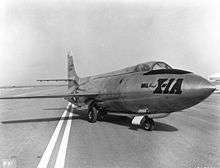 |
1951 | High-speed and high-altitude flight | |
| X-1E | Bell | USAF, NACA |  |
1955 | High-speed and high-altitude flight | |
| X-2 | Bell | USAF |  |
1952 | High-speed and high-altitude flight | First aircraft to exceed Mach 3.[4]:8 |
| X-3 Stiletto |
Douglas | USAF, NACA |  |
1952 | Highly loaded trapezoidal wing | Titanium alloy construction; Underpowered, but provided insights into inertia coupling.[4]:9 |
| X-4 Bantam |
Northrop | USAF, NACA |  |
1948 | Transonic tailless aircraft[4]:10 | |
| X-5 | Bell | USAF, NACA |  |
1951 | variable geometry | First aircraft to fly with variable wing sweep.[4]:11 |
| X-6 | Convair | USAF, AEC |  |
1957 | Nuclear Propulsion | Not built. The Convair NB-36H was a B-36 modified to carry a nuclear reactor and flew from 1955 to 1957.[4]:12[7] |
| X-7 | Lockheed | USAF, USA, USN | 1951 | Ramjet engines.[4]:13 | ||
| X-8 Aerobee |
Aerojet | NACA, USAF, USN | 1949 | Upper air research[4]:14 | Later models used as sounding rockets. | |
| X-9 Shrike |
Bell | USAF | 1949 | Guidance and propulsion technology | Assisted development of GAM-63 Rascal missile.[4]:15 | |
| X-10 | North American | USAF |  |
1953 | SM-64 Navajo missile testbed.[4]:16 | |
| X-11 | Convair | USAF |  |
1957 | SM-65 Atlas missile testbed.[4]:17 | |
| X-12 | Convair | USAF | 1957 | SM-65 Atlas missile testbed.[4][4]:18 | ||
| X-13 Vertijet |
Ryan | USAF, USN |  |
1955 | Vertical takeoff and landing (VTOL) | tailsitting VTOL flight.[4]:19 |
| X-14 | Bell | USAF, NASA |  |
1957 | VTOL | Vectored thrust configuration for VTOL flight.[4]:20 |
| X-15 | North American | USAF, NASA |  |
1959 | Hypersonic, high-altitude flight | First manned hypersonic aircraft; capable of suborbital spaceflight.[4]:21–22 |
| X-15 A-2 | North American | USAF, NASA | 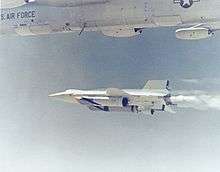 |
1954 | Hypersonic, high-altitude flight | Major Pete Knight flew the X-15 A-2 to a Mach 6.70, making it the fastest piloted flight of the X-plane program. |
| X-16 | Bell | USAF | 1954 | High-altitude reconnaissance[4]:23 | "X-16" designation used to hide true purpose.[8] Cancelled and never flew. | |
| X-17 | Lockheed | USAF, USN | 1956 | High Mach number reentry.[4]:24 | ||
| X-18 | Hiller | USAF, USN |  |
1959 | Vertical and/or short take-off and landing (V/STOL) | Evaluated the tiltwing concept for VTOL flight.[4]:25 |
| X-19 | Curtiss-Wright | Tri-service | 1963 | Tandem tiltrotor VTOL[4]:26 | XC-143 designation proposed.[9] | |
| X-20 Dyna-Soar |
Boeing | USAF |  |
1963 | Reusable spaceplane | Military missions.[4]:27 Cancelled and never built. |
| X-21A | Northrop | USAF |  |
1963 | Boundary layer control[4]:28 | |
| X-22 | Bell | Tri-service |  |
1966 | Quad ducted fan tiltrotor STOVL[4]:29 | |
| X-23 PRIME |
Martin Marietta | USAF | 1966 | Maneuvering atmospheric reentry[4]:30 | Designation never officially assigned.[10] | |
| X-24A | Martin Marietta | USAF, NASA |  |
1969 | Low-speed lifting body[4]:31 | |
| X-24B | Martin Marietta | USAF, NASA |  |
1973 | Low-speed lifting body[4]:32 | |
| X-25 | Bensen | USAF | 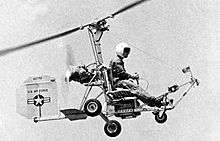 |
1955 | Commercial light autogyro for downed pilots.[4]:33 | |
| X-26 Frigate |
Schweizer | DARPA, US Army, USN |   |
1967 | Training glider for yaw-roll coupling Quiet observation aircraft[4]:34 |
|
| X-27 | Lockheed | None |  |
1971 | High-performance fighter[4]:35 | Cancelled and never flew. |
| X-28 Sea Skimmer |
Osprey | USN |  |
1970 | Low-cost aerial policing seaplane[4]:36 | |
| X-29 | Grumman | DARPA, USAF, NASA | 1984 | Forward-swept wing[4]:37 | ||
| X-30 NASP |
Rockwell | NASA, DARPA, USAF |  |
1993 | Single stage to orbit spaceplane[4]:38 | Cancelled and never built. |
| X-31 | Rockwell-MBB | DARPA, USAF, BdV | 1990 | Thrust vectoring supermaneuverability[4]:39 | ||
| X-32A | Boeing | USAF, USN, USMC, RAF | 2000 | Joint Strike Fighter[4]:40–41 | ||
| X-32B | Boeing | USAF, USN, RAF |  |
2001 | Joint Strike Fighter[4]:40–41 | |
| X-33 Venture Star |
Lockheed Martin | NASA |  |
N/A | Half-scale reusable launch vehicle prototype.[4]:42 | Prototype never completed. |
| X-34 | Orbital Sciences | NASA |  |
N/A | Reusable unmanned spaceplane.[4]:43 | Never flew. |
| X-35A | Lockheed Martin | USAF, USN, USMC, RAF |  |
2000 | Joint Strike Fighter[4]:44–45 | |
| X-35B | Lockheed Martin | USAF, USN, USMC, RAF | 2001 | Joint Strike Fighter[4]:44–45 | ||
| X-35C | Lockheed Martin | USAF, USN, USMC, RAF |  |
2000 | Joint Strike Fighter[4]:44–45 | |
| X-36 | McDonnell Douglas | NASA |  |
1997 | 28% scale tailless fighter[4]:46 | |
| X-37 | Boeing | USAF, NASA | 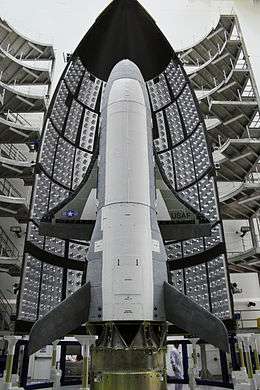 |
2010 | Reusable orbital spaceplane[4]:47 | Drop test performed in 2006. |
| X-38 | Scaled Composites | NASA |  |
1998 | Lifting body Crew Return Vehicle[4]:48 | |
| X-39 | Unknown | USAF | Classified | Future Aircraft Technology Enhancements (FATE) program.[4]:49 | Designation never officially assigned.[10] | |
| X-40A | Boeing | USAF, NASA | 1998 | 80% scale Space Maneuver Vehicle X-37 prototype.[4]:50 |
||
| X-41 | Unknown | USAF | Classified | Maneuvering re-entry vehicle.[4]:51 | ||
| X-42 | Unknown | USAF | Classified | Expendable liquid propellant upper-stage rocket.[4]:52 | ||
| X-43 Hyper-X |
Micro Craft | NASA |  |
2001 | Hypersonic Scramjet[4]:53 | |
| X-44 MANTA |
Lockheed Martin | USAF, NASA | N/A | F-22-based Multi-Axis No-Tail Aircraft thrust vectoring[4]:54 | Cancelled, never flew. | |
| X-45 | Boeing | DARPA, USAF | 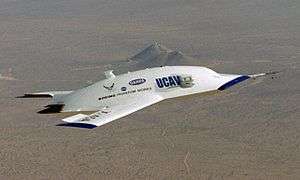 |
2002 | Unmanned combat air vehicle (UCAV)[4]:55 | |
| X-46 | Boeing | DARPA, USN |  |
N/A | Unmanned combat air vehicle (UCAV).[4]:56 | Naval use. Cancelled, never flew. |
| X-47A Pegasus X-47B |
Northrop Grumman | DARPA, USN |  |
2003 | Unmanned combat air vehicle (UCAV)[4]:57 | Naval use. |
| X-48 | Boeing | NASA |  |
2007 | Blended Wing Body (BWB)[4]:58 | |
| X-49 Speedhawk |
Piasecki | US Army |  |
2007 | Compound helicopter Vectored Thrust Ducted Propeller (VTDP) testbed.[11] |
|
| X-50 Dragonfly |
Boeing | DARPA |  |
2003 | Canard Rotor/Wing[4]:60 | |
| X-51 Waverider |
Boeing | USAF |  |
2010[12] | Hypersonic scramjet[13] | |
| X-52 | — | — | — | — | — | Number skipped to avoid confusion with Boeing B-52 Stratofortress.[10] |
| X-53 | Boeing | NASA, USAF | 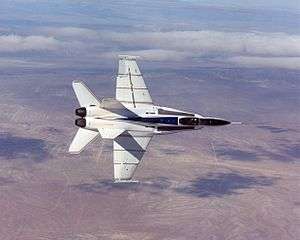 |
2002 | Active Aeroelastic Wing[14] | |
| X-54 | Gulfstream | NASA | N/A | Supersonic transport[15] in development. | ||
| X-55 | Lockheed Martin | USAF | 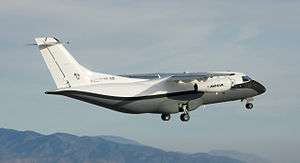 |
2009 | Advanced Composite Cargo Aircraft (ACCA)[16] | |
| X-56 | Lockheed Martin | USAF/NASA |  |
2012 | Active flutter suppression and gust load alleviation | Part of the high-altitude, long-endurance (HALE) reconnaissance aircraft program.[17] |
| X-57 Maxwell |
ESAero/Tecnam | NASA | 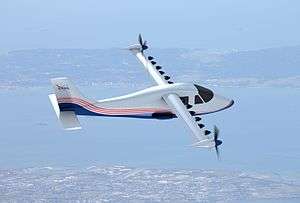 |
2016 | Low emission plane powered entirely by electric motors[18] | Part of NASA's Scalable Convergent Electric Propulsion Technology Operations Research project[18] |
See also
Notes
- ↑ For example, the Piasecki PA-97
- ↑ For example, the NASA AD-1 and Bell XV-15
- ↑ For example, the Northrop Tacit Blue
References
- ↑ "X-Planes Experimental Aircraft". Federation of American Scientists. Retrieved 2012-06-01.
- ↑ Miller 2001, p. 209
- ↑ First Generation X-1 (fact sheet), Dryden: NASA, retrieved May 8, 2010.
- 1 2 3 4 5 6 7 8 9 10 11 12 13 14 15 16 17 18 19 20 21 22 23 24 25 26 27 28 29 30 31 32 33 34 35 36 37 38 39 40 41 42 43 44 45 46 47 48 49 50 51 52 53 54 55 Jenkins, Landis and Miller 2003
- ↑ A history of the Joint Strike Fighter Program, UK: Martin-Baker, January 2010.
- ↑ "D-558-I" NASA Dryden Fact Sheets. NASA. Accessed May 8, 2010.
- ↑ Miller, J. The X-Planes, Speciality Press, 1983.
- ↑ "X-16". Global security, accessed 11 May 2010.
- ↑ Baugher 2007
- 1 2 3 Parsch 2009, "Missing Designations"
- ↑ Parsch 2009, "DOD 4120.15-L"
- ↑ "X-51 Waverider makes historic hypersonic flight". US Air Force Public Affairs. 26 May 2010. Retrieved 27 May 2010.
- ↑ "X-51 Scramjet Engine Demonstrator - WaveRider" globalsecurity.org. Accessed 2010-05-11.
- ↑ Jordan 2006
- ↑ 412015-L
- ↑ Kaufman 2009
- ↑ Norris 2012
- 1 2 Harrington, J.D.; Kamlet, Matt; Barnstorff, Kathy (17 June 2016). "NASA Hybrid Electric Research Plane Gets X Number, New Name". NASA.gov. NASA. Retrieved 17 June 2016.
Bibliography
- Baugher, Joe (2007). "Cargo Aircraft Designations". Retrieved 11 May 2010.
- Jenkins, Dennis R.; Tony Landis; Jay Miller (June 2003). American X-Vehicles: An Inventory—X-1 to X-50 (NASA Special Publication; PDF). Monographs in Aerospace History. No. 31 (Centennial of Flight ed.). Washington, DC: NASA History Office. SP-2003-4531. Retrieved 5 April 2010.
- Jordan, Holly (2006). "Active Aeroelastic Wing flight research vehicle receives X-53 designation". Wright-Patterson Air Force Base. Retrieved 2010-05-11.
- Kaufman, Derek (2009). "Advanced Composite Cargo Aircraft gets X-plane designation". United States Air Force. Retrieved 2010-05-11.
- Miller, Jay (2001). The X-Planes: X-1 to X-45 (third ed.). Motorbooks International. ISBN 1-85780-109-1.
- Parsch, Andreas (November 2009). ""Missing" USAF/DOD Aircraft Designations". designation-systems.net. Retrieved 2010-05-11.
- Parsch, Andreas (November 2009). "DOD 4120.15-L - Addendum, MDS Designators allocated after 19 August 1998 (until September 2009)". designation-Systems.Net. Retrieved 2010-05-11.
- Norris, Guy (February 2012). "USAF Reveals Latest X-Plane: X-56A". Aviation Week and Space Technology. Retrieved 2012-02-11.
External links
| Wikimedia Commons has media related to X-planes. |